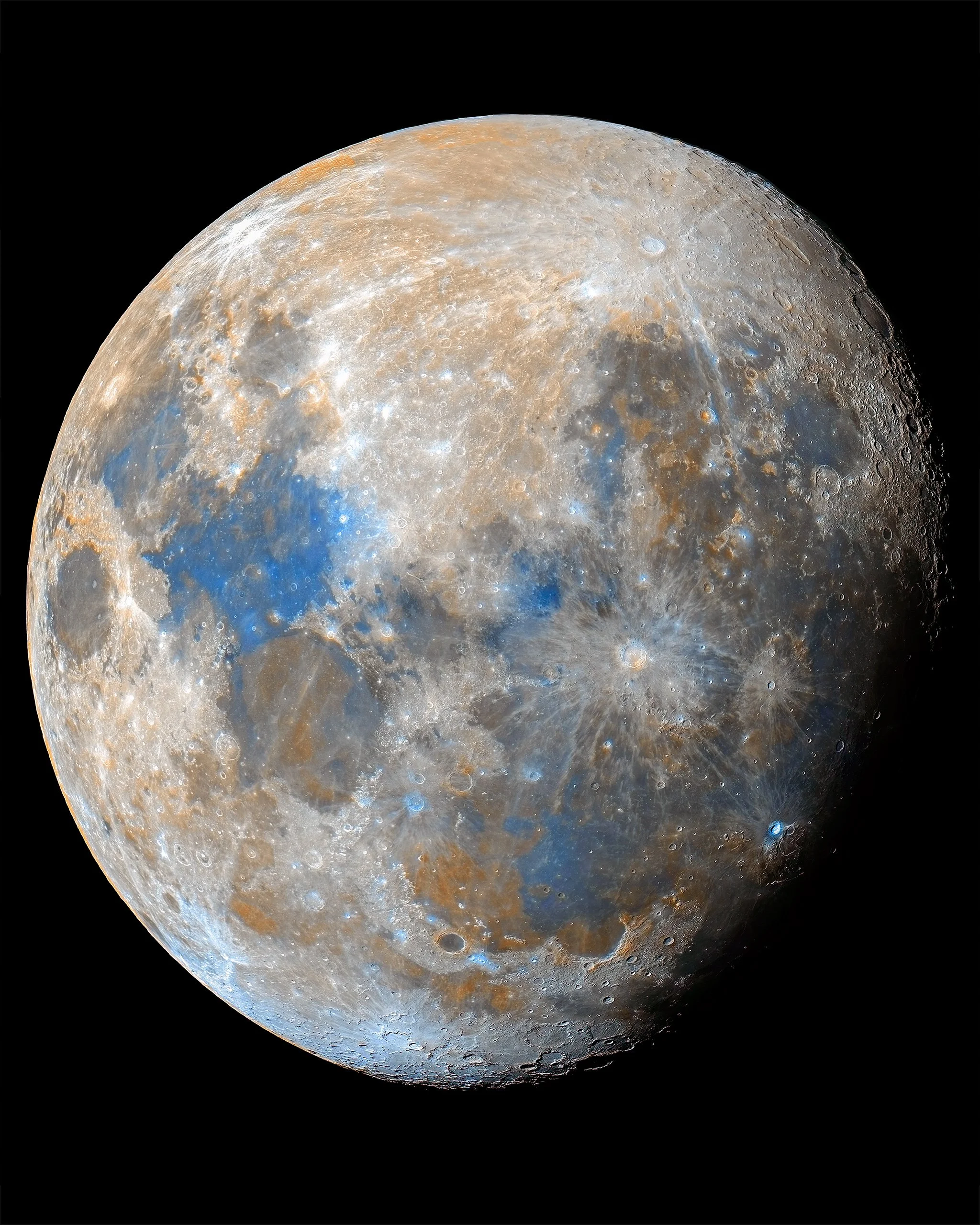
AAPOD2 Image Archives
M51 widefield
Messier 51, commonly known as the Whirlpool Galaxy, is a spiral galaxy located in the constellation Canes Venatici, at a distance of 31 million light-years. It was discovered by French astronomer Charles Messier on October 13, 1773, while observing a comet. Years later, in 1781, Messier's disciple, Pierre Méchain, discovered M51's companion, which they named M51B. M51 Whirlpool Galaxy.
Selenochromatic almost Full Moon
This image presents the Moon in a selenochromatic view, enhancing the colors to better showcase the differences in soil compositions across its surface. By exaggerating the natural hues, this technique highlights variations in mineral content and soil types that are not visible to the naked eye. The dark basaltic plains, known as lunar maria, appear in shades of blue and gray, indicating high levels of titanium and iron.
In contrast, the highlands, which are rich in anorthosite and calcium, show up in brighter colors, often with a reddish or orange tint. This enhanced color view provides valuable insights into the geological history of the Moon, revealing the complex processes that have shaped its surface over billions of years. Through these subtle differences, scientists can better understand the Moon's composition and the impact history of the lunar surface.
Sl7 Dark Nebula
SL7 is a dark nebula, a region of space so dense with interstellar dust that it obscures the light from stars and other objects behind it. Located in the Milky Way, dark nebulae like SL7 are fascinating to astronomers because they are the birthplaces of stars. These dense molecular clouds provide the raw materials for star formation, with gravity pulling the gas and dust together until nuclear fusion ignites a new star.
In this image, the dense, dark silhouette of SL7 stands out against the backdrop of the Milky Way, blocking the light from more distant stars. The intricate structures and variations in density within the nebula are visible, offering a glimpse into the complex processes at play in these stellar nurseries. Observing and studying dark nebulae like SL7 helps astronomers understand the early stages of star formation and the conditions that lead to the birth of stars and planetary systems.
The Propeller nebula
Image Description and Details : The Propeller nebula is a target that I have tried before in 2019, but this time I wanted to add more Oiii and make it stand out in the final image.
The data captured this year wasn't really enough, so I stacked the new data with everything I had from my previous attempt and I can finally say that I am pleased with the final result.
The equipment used in 2019:
Eq6 Hypertuned mount
Skywatcher 130pds f5 newtonian telescope with Skywatcher x0.9 coma corrector
AstroTech 106LE with upgraded Moonlite focuser and TSFlat 2" field Flattener
Rigel nStep atofocuser
QHY183m Cmos camera, cooled at -20°C
7x1.25" StarlightXpress USB filterwheel
Baader 1.25" 7nm Ha filter
Baader 1.25" 8.5nm Oiii filter
Baader 1.25" 8nm Sii filter
TS65Q as guidescope
QHY5L-IIM guidecam
QHYCCD Polemaster
TS 09 OAG off axis guider
The equipment used in 2023:
Mount: StellarDrive GT6
AstroTech 106LE with upgraded Moonlite focuser
TSFlat 2" field flattener
ASI294MM Pro Cmos camera, cooled at - 15°C
8x1.25" ZWO USB filterwheel
Chroma 1.25" RGB and Chroma 1.25" 3nm SHO filters
Qhyccd QHY5L-IIM guide camera
OpticStar AR90 as guidescope
Qhyccd Polemaster
Software used:
Eqmod, APT, SGP, Stellarium with StellariumScope, PHD2
Location:
2019 - Bushey, Hertfordshire, Bortle 6
2023 - Hemel Hempstead, Hertfordshire, bortle 5
Dates:
18 April to 05 September 2019 and 23 June to 7 July 2023
Frames:
Baader H-alpha 7nm 1.25": 78×300″(6h 30′)
Baader H-alpha 7nm 1.25": 16×600″(2h 40′)
Baader O-III 8.5nm 1.25": 29×600″(4h 50′)
Baader S-II 8nm 1.25": 30×600″(5h)
Chroma Blue 1.25": 10×60″(10′)
Chroma Green 1.25": 10×60″(10′)
Chroma H-alpha 3nm Bandpass 1.25": 50×300″(4h 10′)
Chroma OIII 3nm Bandpass 1.25": 50×600″(8h 20′)
Chroma Red 1.25": 10×60″(10′)
Chroma SII 3nm Bandpass 1.25": 50×300″(4h 10′)
Total integration time: 36h 10′
The stacking, calibration and blending was done in AstroPixel Processor and the post processing in Pixinsight (with help from Star Xterminator and Noise Xterminator and Blur Xterminator) and Photoshop CC 2023
Copyright: Emil Andronic





